转载请声明出处哦~,本篇文章发布于luozhiyun的博客:https://www.luozhiyun.com
本文使用的go的源码15.7
介绍
Go 语言的内存分配器就借鉴了 TCMalloc 的设计实现高速的内存分配,它的核心理念是使用多级缓存将对象根据大小分类,并按照类别实施不同的分配策略。TCMalloc 相关的信息可以看这里:http://goog-perftools.sourceforge.net/doc/tcmalloc.html。
即如果要分配的对象是个小对象(<= 32k),在每个线程中都会有一个无锁的小对象缓存,可以直接高效的无锁的方式进行分配;
如下:对象被分到不同的内存大小组中的链表中。
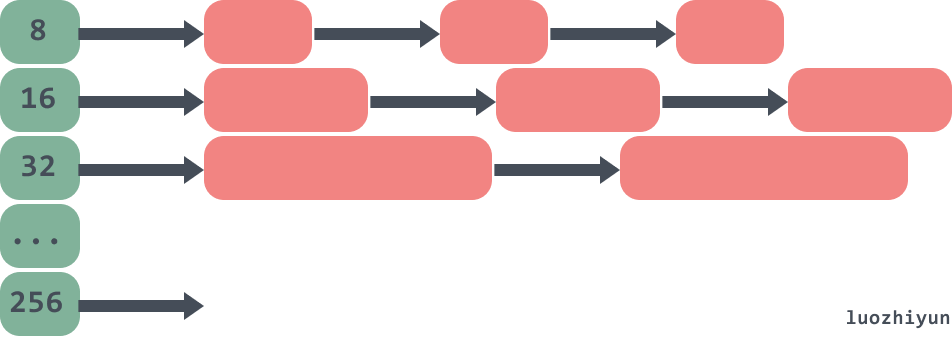
如果是个大对象(>32k),那么页堆进行分配。如下:
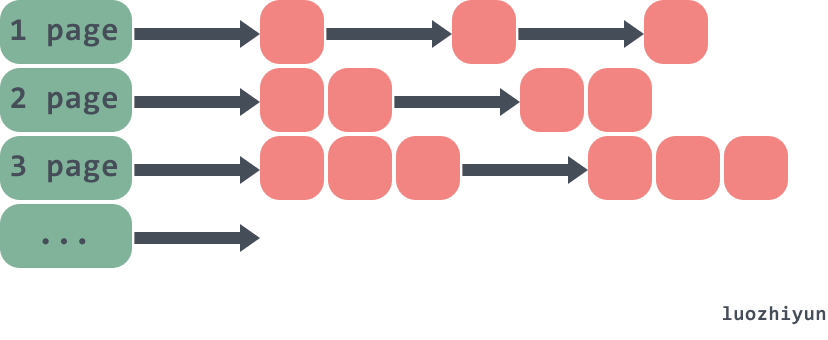
虽然go内存分配器最初是基于tcmalloc的,但是现在已经有了很大的不同。所以上面的一些结构会有些许变化,下面再慢慢絮叨。
因为内存分配的源码比较复杂,为了方便大家调试,所以在进行源码分析之前,先看看是如何断点汇编来进行调试的。
断点调试汇编
目前Go语言支持GDB、LLDB和Delve几种调试器。只有Delve是专门为Go语言设计开发的调试工具。而且Delve本身也是采用Go语言开发,对Windows平台也提供了一样的支持。本节我们基于Delve简单解释如何调试Go汇编程序。项目地址:https://github.com/go-delve/delve
安装:
go get github.com/go-delve/delve/cmd/dlv
首先编写一个test.go的一个例子:
package main
import "fmt"
type A struct {
test string
}
func main() {
a := new(A)
fmt.Println(a)
}
然后命令行进入包所在目录,然后输入dlv debug命令进入调试:
PS C:\document\code\test_go\src> dlv debug
Type 'help' for list of commands.
然后可以使用break命令在main包的main方法上设置一个断点:
(dlv) break main.main
Breakpoint 1 set at 0x4bd30a for main.main() c:/document/code/test_go/src/test.go:8
通过breakpoints查看已经设置的所有断点:
(dlv) breakpoints
Breakpoint runtime-fatal-throw at 0x4377e0 for runtime.fatalthrow() c:/software/go/src/runtime/panic.go:1162 (0)
Breakpoint unrecovered-panic at 0x437860 for runtime.fatalpanic() c:/software/go/src/runtime/panic.go:1189 (0)
print runtime.curg._panic.arg
Breakpoint 1 at 0x4bd30a for main.main() c:/document/code/test_go/src/test.go:8 (0)
通过continue命令让程序运行到下一个断点处:
(dlv) continue
> main.main() c:/document/code/test_go/src/test.go:8 (hits goroutine(1):1 total:1) (PC: 0x4bd30a)
3: import "fmt"
4:
5: type A struct {
6: test string
7: }
=> 8: func main() {
9: a := new(A)
10: fmt.Println(a)
11: }
12:
13:
通过disassemble反汇编命令查看main函数对应的汇编代码:
(dlv) disassemble
TEXT main.main(SB) C:/document/code/test_go/src/test.go
test.go:8 0x4bd2f0 65488b0c2528000000 mov rcx, qword ptr gs:[0x28]
test.go:8 0x4bd2f9 488b8900000000 mov rcx, qword ptr [rcx]
test.go:8 0x4bd300 483b6110 cmp rsp, qword ptr [rcx+0x10]
test.go:8 0x4bd304 0f8697000000 jbe 0x4bd3a1
=> test.go:8 0x4bd30a* 4883ec78 sub rsp, 0x78
test.go:8 0x4bd30e 48896c2470 mov qword ptr [rsp+0x70], rbp
test.go:8 0x4bd313 488d6c2470 lea rbp, ptr [rsp+0x70]
test.go:9 0x4bd318 488d0581860100 lea rax, ptr [__image_base__+874912]
test.go:9 0x4bd31f 48890424 mov qword ptr [rsp], rax
test.go:9 0x4bd323 e8e800f5ff call $runtime.newobject
test.go:9 0x4bd328 488b442408 mov rax, qword ptr [rsp+0x8]
test.go:9 0x4bd32d 4889442430 mov qword ptr [rsp+0x30], rax
test.go:10 0x4bd332 4889442440 mov qword ptr [rsp+0x40], rax
test.go:10 0x4bd337 0f57c0 xorps xmm0, xmm0
test.go:10 0x4bd33a 0f11442448 movups xmmword ptr [rsp+0x48], xmm0
test.go:10 0x4bd33f 488d442448 lea rax, ptr [rsp+0x48]
test.go:10 0x4bd344 4889442438 mov qword ptr [rsp+0x38], rax
test.go:10 0x4bd349 8400 test byte ptr [rax], al
test.go:10 0x4bd34b 488b4c2440 mov rcx, qword ptr [rsp+0x40]
test.go:10 0x4bd350 488d15099f0000 lea rdx, ptr [__image_base__+815712]
test.go:10 0x4bd357 4889542448 mov qword ptr [rsp+0x48], rdx
test.go:10 0x4bd35c 48894c2450 mov qword ptr [rsp+0x50], rcx
test.go:10 0x4bd361 8400 test byte ptr [rax], al
test.go:10 0x4bd363 eb00 jmp 0x4bd365
test.go:10 0x4bd365 4889442458 mov qword ptr [rsp+0x58], rax
test.go:10 0x4bd36a 48c744246001000000 mov qword ptr [rsp+0x60], 0x1
test.go:10 0x4bd373 48c744246801000000 mov qword ptr [rsp+0x68], 0x1
test.go:10 0x4bd37c 48890424 mov qword ptr [rsp], rax
test.go:10 0x4bd380 48c744240801000000 mov qword ptr [rsp+0x8], 0x1
test.go:10 0x4bd389 48c744241001000000 mov qword ptr [rsp+0x10], 0x1
test.go:10 0x4bd392 e869a0ffff call $fmt.Println
test.go:11 0x4bd397 488b6c2470 mov rbp, qword ptr [rsp+0x70]
test.go:11 0x4bd39c 4883c478 add rsp, 0x78
test.go:11 0x4bd3a0 c3 ret
test.go:8 0x4bd3a1 e82a50faff call $runtime.morestack_noctxt
.:0 0x4bd3a6 e945ffffff jmp $main.main
现在我们可以使用break断点到runtime.newobject函数的调用上:
(dlv) break runtime.newobject
Breakpoint 2 set at 0x40d426 for runtime.newobject() c:/software/go/src/runtime/malloc.go:1164
输入continue跳到断点的位置:
(dlv) continue
> runtime.newobject() c:/software/go/src/runtime/malloc.go:1164 (hits goroutine(1):1 total:1) (PC: 0x40d426)
Warning: debugging optimized function
1159: }
1160:
1161: // implementation of new builtin
1162: // compiler (both frontend and SSA backend) knows the signature
1163: // of this function
=>1164: func newobject(typ *_type) unsafe.Pointer {
1165: return mallocgc(typ.size, typ, true)
1166: }
1167:
1168: //go:linkname reflect_unsafe_New reflect.unsafe_New
1169: func reflect_unsafe_New(typ *_type) unsafe.Pointer {
print命令来查看typ的数据:
(dlv) print typ
*runtime._type {size: 16, ptrdata: 8, hash: 875453117, tflag: tflagUncommon|tflagExtraStar|tflagNamed (7), align: 8, fieldAlign: 8, kind: 25, equal: runtime.strequal, gcdata: *1, str: 5418, ptrToThis: 37472}
可以看到这里打印的size是16bytes,因为我们A结构体里面就一个string类型的field。
进入到mallocgc方法后,通过args和locals命令查看函数的参数和局部变量:
(dlv) args
size = (unreadable could not find loclist entry at 0x8b40 for address 0x40ca73)
typ = (*runtime._type)(0x4d59a0)
needzero = true
~r3 = (unreadable empty OP stack)
(dlv) locals
(no locals)
各个对象入口
我们根据汇编可以判断,所有的函数入口都是runtime.mallocgc,但是下面两个对象需要注意一下:
int64对象
runtime.convT64
func convT64(val uint64) (x unsafe.Pointer) {
if val < uint64(len(staticuint64s)) {
x = unsafe.Pointer(&staticuint64s[val])
} else {
x = mallocgc(8, uint64Type, false)
*(*uint64)(x) = val
}
return
}
这段代码表示如果一个int64类型的值小于256,直接十三姨的是缓存值,那么这个值不会进行内存分配。
string对象
runtime.convTstring
func convTstring(val string) (x unsafe.Pointer) {
if val == "" {
x = unsafe.Pointer(&zeroVal[0])
} else {
x = mallocgc(unsafe.Sizeof(val), stringType, true)
*(*string)(x) = val
}
return
}
由这段代码显示,如果是创建一个为”“的string对象,那么会直接返回一个固定的地址值,不会进行内存分配。
分析
分配器的组件
内存分配是由内存分配器完成,分配器由3种组件构成:runtime.mspan、runtime.mcache、runtime.mcentral、runtime.mheap。
runtime.mspan
type mspan struct {
// 上一个节点
next *mspan
// 下一个节点
prev *mspan
// span集合
list *mSpanList
// span开始的地址值
startAddr uintptr
// span管理的页数
npages uintptr
// Object n starts at address n*elemsize + (start << pageShift).
// 空闲节点的索引
freeindex uintptr
// span中存放的对象数量
nelems uintptr
// 用于快速查找内存中未被使用的内存
allocCache uint64
// 用于计算mspan管理了多少内存
elemsize uintptr
// span的结束地址值
limit uintptr
...
}
runtime.mspan是内存管理器里面的最小粒度单元,所有的对象都是被管理在mspan下面。
mspan是一个链表,有上下指针;
npages代表mspan管理的堆页的数量;
freeindex是空闲对象的索引;
nelems代表这个mspan中可以存放多少对象,等于(npages * pageSize)/elemsize;
allocCache用于快速的查找未被使用的内存地址;
elemsize表示一个对象会占用多个个bytes,等于class_to_size[sizeclass],需要注意的是sizeclass每次获取的时候会sizeclass方法,将sizeclass>>1;
limit表示span结束的地址值,等于startAddr+ npages*pageSize;
实例图如下:
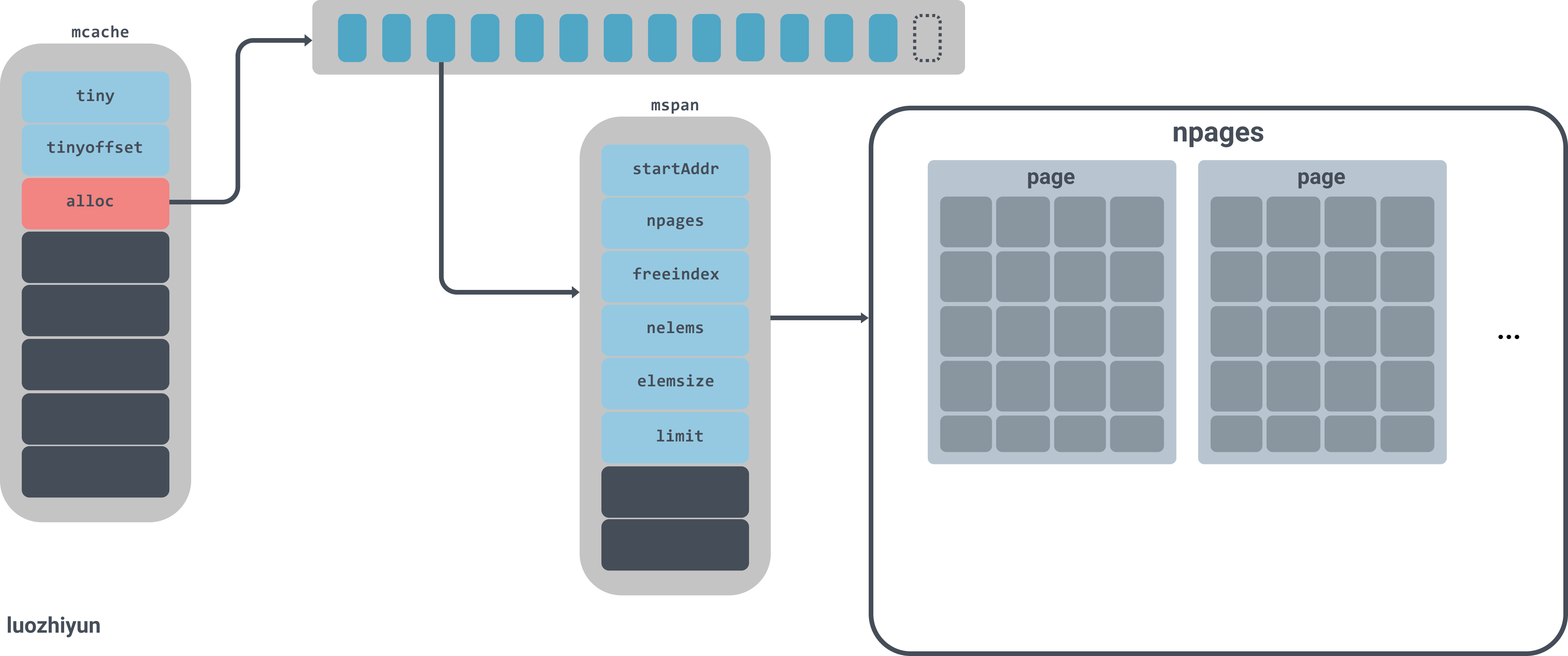
图中alloc是一个拥有137个元素的mspan数组,mspan数组管理数个page大小的内存,每个page是8k,page的数量由spanclass规格决定。
runtime.mcache
type mcache struct {
...
// 申请小对象的起始地址
tiny uintptr
// 从起始地址tiny开始的偏移量
tinyoffset uintptr
// tiny对象分配的数量
local_tinyallocs uintptr // number of tiny allocs not counted in other stats
// mspan对象集合,numSpanClasses=134
alloc [numSpanClasses]*mspan // spans to allocate from, indexed by spanClass
...
}
runtime.mcache是绑在并发模型GPM的P上,在分配微对象和小对象的时候会先去runtime.mcache中获取,每一个处理器都会被分配一个线程缓存runtime.mcache,因此从runtime.mcache进行分配时无需加锁。
在runtime.mcache中有一个alloc数组,是runtime.mspan的集合,runtime.mspan是 Go 语言内存管理的基本单元。对于[16B,32KB]的对象会使用这部分span进行内存分配,所以所有在这区间大小的对象都会从alloc这个数组里寻找,下面会分析到。
runtime.mcentral
type mcentral struct {
lock mutex
//spanClass Id
spanclass spanClass
// 空闲的span列表
nonempty mSpanList // list of spans with a free object, ie a nonempty free list
// 已经被使用的span列表
empty mSpanList // list of spans with no free objects (or cached in an mcache)
//分配mspan的累积计数
nmalloc uint64
}
type mSpanList struct {
//链表头
first *mspan // first span in list, or nil if none
//链表尾部
last *mspan // last span in list, or nil if none
}
当runtime.mcache中空间不足的时候,会去runtime.mcentral中申请对应规格的mspan。由于由于runtime.mcentral是公共资源,会有多个runtime.mcache向它申请runtime.mspan,因此必须加锁。
在runtime.mcentral中,有spanclass标识,spanclass表示这个mcentral的类型,下面我们会看到,在分配[16B,32KB]大小对象的时候,会将对象的大小分成67组:
var class_to_size = [_NumSizeClasses]uint16{0, 8, 16, 32, 48, 64, 80, 96, 112, 128, 144, 160, 176, 192, 208, 224, 240, 256, 288, 320, 352, 384, 416, 448, 480, 512, 576, 640, 704, 768, 896, 1024, 1152, 1280, 1408, 1536, 1792, 2048, 2304, 2688, 3072, 3200, 3456, 4096, 4864, 5376, 6144, 6528, 6784, 6912, 8192, 9472, 9728, 10240, 10880, 12288, 13568, 14336, 16384, 18432, 19072, 20480, 21760, 24576, 27264, 28672, 32768}
所以runtime.mcentral只负责一种spanclass规格类型,该规格的所有未被使用的空闲mspan会挂载到nonempty 链表上,已经被mcache拿走,未归还的会挂载到empty 链表上,归还后会再挂载到nonempty上。mspan会以链表的形式链接在runtime.mcentral上面。

runtime.mheap
type mheap struct {
lock mutex
pages pageAlloc // page allocation data structure
//arenas数组集合,一个二维数组
arenas [1 << arenaL1Bits]*[1 << arenaL2Bits]*heapArena
//各个规格的mcentral集合
central [numSpanClasses]struct {
mcentral mcentral
pad [cpu.CacheLinePadSize - unsafe.Sizeof(mcentral{})%cpu.CacheLinePadSize]byte
}
...
}
对于runtime.mheap需要关注central和arenas。central是各个规格的mcentral集合,在初始化的时候会通过遍历class_to_size来进行创建;arenas是一个二维数组,用来管理内存空间。arenas由多个runtime.heapArena组成,每个单元都会管理 64MB 的内存空间:
const (
pageSize = 8192 // 8KB
heapArenaBytes = 67108864 // 64MB
pagesPerArena = heapArenaBytes / pageSize // 8192
)
type heapArena struct {
bitmap [heapArenaBitmapBytes]byte
spans [pagesPerArena]*mspan
pageInUse [pagesPerArena / 8]uint8
pageMarks [pagesPerArena / 8]uint8
zeroedBase uintptr
}
需要注意的是,上面的heapArenaBytes代表的64M只是在除windows以外的64 位机器才会显示,在windows机器上显示的是4MB。具体的可以看下面的官方注释:
// Platform Addr bits Arena size L1 entries L2 entries
// -------------- --------- ---------- ---------- -----------
// */64-bit 48 64MB 1 4M (32MB)
// windows/64-bit 48 4MB 64 1M (8MB)
// */32-bit 32 4MB 1 1024 (4KB)
// */mips(le) 31 4MB 1 512 (2KB)
L1 entries、L2 entries分别代表的是runtime.mheap中arenas一维、二维的值。
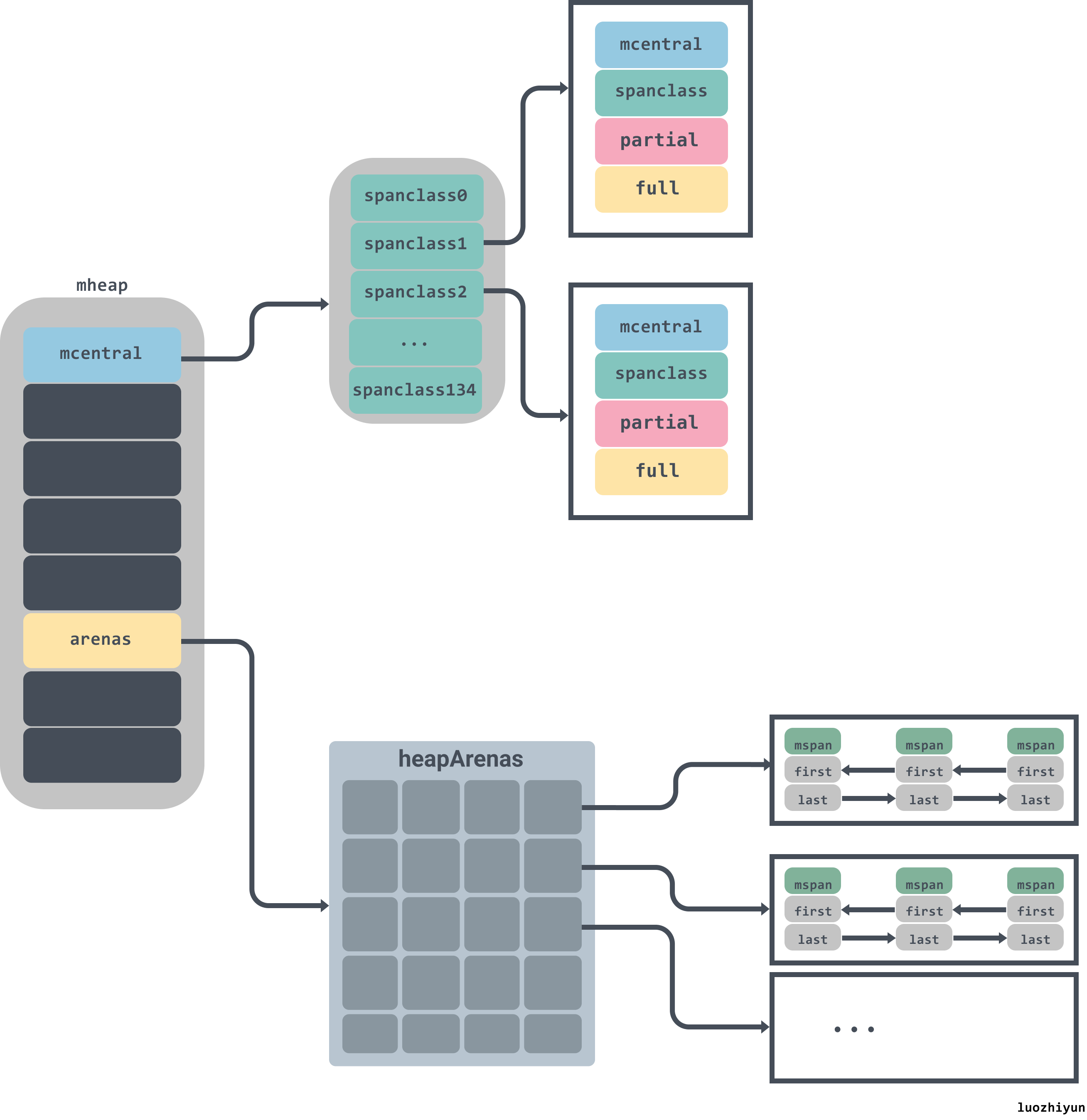
给对象分配内存
我们通过对源码的反编译可以知道,堆上所有的对象都会通过调用runtime.newobject函数分配内存,该函数会调用runtime.mallocgc:
//创建一个新的对象
func newobject(typ *_type) unsafe.Pointer {
//size表示该对象的大小
return mallocgc(typ.size, typ, true)
}
func mallocgc(size uintptr, typ *_type, needzero bool) unsafe.Pointer {
...
dataSize := size
// 获取mcache,用于处理微对象和小对象的分配
c := gomcache()
var x unsafe.Pointer
// 表示对象是否包含指针,true表示对象里没有指针
noscan := typ == nil || typ.ptrdata == 0
// maxSmallSize=32768 32k
if size <= maxSmallSize {
// maxTinySize= 16 bytes
if noscan && size < maxTinySize {
...
} else {
...
}
// 大于 32 Kb 的内存分配,通过 mheap 分配
} else {
...
}
...
return x
}
通过mallocgc的代码可以知道,mallocgc在分配内存的时候,会按照对象的大小分为3档来进行分配:
- 小于16bytes的小对象;
- 在16bytes与32k之间的微对象;
- 大于 32 Kb的大对象;
大对象分配
func mallocgc(size uintptr, typ *_type, needzero bool) unsafe.Pointer {
...
var s *mspan
shouldhelpgc = true
systemstack(func() {
s = largeAlloc(size, needzero, noscan)
})
s.freeindex = 1
s.allocCount = 1
x = unsafe.Pointer(s.base())
size = s.elemsize
...
return x
}
从上面我们可以看到分配大于32KB的空间时,直接使用largeAlloc来分配一个mspan。
func largeAlloc(size uintptr, needzero bool, noscan bool) *mspan {
// _PageSize=8k,也就是表明对象太大,溢出
if size+_PageSize < size {
throw("out of memory")
}
// _PageShift==13,计算需要分配的页数
npages := size >> _PageShift
// 如果不是整数,多出来一些,需要加1
if size&_PageMask != 0 {
npages++
}
...
// 从堆上分配
s := mheap_.alloc(npages, makeSpanClass(0, noscan), needzero)
if s == nil {
throw("out of memory")
}
...
return s
}
在分配内存的时候是按页来进行分配的,每个页的大小是_PageSize(8K),然后需要根据传入的size来判断需要分多少页,最后调用alloc从堆上分配。
func (h *mheap) alloc(npages uintptr, spanclass spanClass, needzero bool) *mspan {
var s *mspan
systemstack(func() {
if h.sweepdone == 0 {
// 回收一部分内存
h.reclaim(npages)
}
// 进行内存分配
s = h.allocSpan(npages, false, spanclass, &memstats.heap_inuse)
})
...
return s
}
继续看allocSpan的实现:
const pageCachePages = 8 * unsafe.Sizeof(pageCache{}.cache)
func (h *mheap) allocSpan(npages uintptr, manual bool, spanclass spanClass, sysStat *uint64) (s *mspan) {
// Function-global state.
gp := getg()
base, scav := uintptr(0), uintptr(0)
pp := gp.m.p.ptr()
// 申请的内存比较小,尝试从pcache申请内存
if pp != nil && npages < pageCachePages/4 {
c := &pp.pcache
if c.empty() {
lock(&h.lock)
*c = h.pages.allocToCache()
unlock(&h.lock)
}
base, scav = c.alloc(npages)
if base != 0 {
s = h.tryAllocMSpan()
if s != nil && gcBlackenEnabled == 0 && (manual || spanclass.sizeclass() != 0) {
goto HaveSpan
}
}
}
lock(&h.lock)
// 内存比较大或者线程的页缓存中内存不足,从mheap的pages上获取内存
if base == 0 {
base, scav = h.pages.alloc(npages)
// 内存也不够,那么进行扩容
if base == 0 {
if !h.grow(npages) {
unlock(&h.lock)
return nil
}
// 重新申请内存
base, scav = h.pages.alloc(npages)
// 内存不足,抛出异常
if base == 0 {
throw("grew heap, but no adequate free space found")
}
}
}
if s == nil {
// 分配一个mspan对象
s = h.allocMSpanLocked()
}
unlock(&h.lock)
HaveSpan:
// 设置参数初始化
s.init(base, npages)
...
// 建立mheap与mspan之间的联系
h.setSpans(s.base(), npages, s)
...
return s
}
这里会根据需要分配的内存大小再判断一次:
- 如果要分配的页数小于
pageCachePages/4=64/4=16页,那么就尝试从pcache申请内存; - 如果申请的内存比较大或者线程的页缓存中内存不足,会通过
runtime.pageAlloc.alloc从页堆分配内存; - 如果页堆上内存不足,那么就mheap的grow方法从系统上申请内存,然后再调用pageAlloc的alloc分配内存;
下面来看看grow的向操作系统申请内存:
func (h *mheap) grow(npage uintptr) bool {
// We must grow the heap in whole palloc chunks.
ask := alignUp(npage, pallocChunkPages) * pageSize
totalGrowth := uintptr(0)
nBase := alignUp(h.curArena.base+ask, physPageSize)
// 内存不够则调用sysAlloc申请内存
if nBase > h.curArena.end {
av, asize := h.sysAlloc(ask)
if av == nil {
print("runtime: out of memory: cannot allocate ", ask, "-byte block (", memstats.heap_sys, " in use)\n")
return false
}
// 重新设置curArena的值
if uintptr(av) == h.curArena.end {
h.curArena.end = uintptr(av) + asize
} else {
if size := h.curArena.end - h.curArena.base; size != 0 {
h.pages.grow(h.curArena.base, size)
totalGrowth += size
}
h.curArena.base = uintptr(av)
h.curArena.end = uintptr(av) + asize
}
nBase = alignUp(h.curArena.base+ask, physPageSize)
}
...
return true
}
grow会通过curArena的end值来判断是不是需要从系统申请内存;如果end小于nBase那么会调用runtime.mheap.sysAlloc方法从操作系统中申请更多的内存;
func (h *mheap) sysAlloc(n uintptr) (v unsafe.Pointer, size uintptr) {
n = alignUp(n, heapArenaBytes)
// 在预先保留的内存中申请一块可以使用的空间
v = h.arena.alloc(n, heapArenaBytes, &memstats.heap_sys)
if v != nil {
size = n
goto mapped
}
// 根据页堆的arenaHints在目标地址上尝试扩容
for h.arenaHints != nil {
hint := h.arenaHints
p := hint.addr
if hint.down {
p -= n
}
if p+n < p {
// We can't use this, so don't ask.
v = nil
} else if arenaIndex(p+n-1) >= 1<<arenaBits {
// Outside addressable heap. Can't use.
v = nil
} else {
// 从操作系统中申请内存
v = sysReserve(unsafe.Pointer(p), n)
}
if p == uintptr(v) {
// Success. Update the hint.
if !hint.down {
p += n
}
hint.addr = p
size = n
break
}
if v != nil {
sysFree(v, n, nil)
}
h.arenaHints = hint.next
h.arenaHintAlloc.free(unsafe.Pointer(hint))
}
...
// 将内存由Reserved转为Prepared
sysMap(v, size, &memstats.heap_sys)
mapped:
// Create arena metadata.
// 初始化一个heapArena来管理刚刚申请的内存
for ri := arenaIndex(uintptr(v)); ri <= arenaIndex(uintptr(v)+size-1); ri++ {
l2 := h.arenas[ri.l1()]
if l2 == nil {
l2 = (*[1 << arenaL2Bits]*heapArena)(persistentalloc(unsafe.Sizeof(*l2), sys.PtrSize, nil))
if l2 == nil {
throw("out of memory allocating heap arena map")
}
atomic.StorepNoWB(unsafe.Pointer(&h.arenas[ri.l1()]), unsafe.Pointer(l2))
}
var r *heapArena
r = (*heapArena)(h.heapArenaAlloc.alloc(unsafe.Sizeof(*r), sys.PtrSize, &memstats.gc_sys))
...
// 将创建heapArena放入到arenas列表中
h.allArenas = h.allArenas[:len(h.allArenas)+1]
h.allArenas[len(h.allArenas)-1] = ri
atomic.StorepNoWB(unsafe.Pointer(&l2[ri.l2()]), unsafe.Pointer(r))
}
return
}
sysAlloc方法会调用runtime.linearAlloc.alloc预先保留的内存中申请一块可以使用的空间;如果没有会调用sysReserve方法会从操作系统中申请内存;最后初始化一个heapArena来管理刚刚申请的内存,然后将创建heapArena放入到arenas列表中。
至此,大对象的分配流程至此结束。
小对象分配
对于介于16bytes~32K的对象分配如下:
func mallocgc(size uintptr, typ *_type, needzero bool) unsafe.Pointer {
...
dataSize := size
// 获取mcache,用于处理微对象和小对象的分配
c := gomcache()
var x unsafe.Pointer
// 表示对象是否包含指针,true表示对象里没有指针
noscan := typ == nil || typ.ptrdata == 0
// maxSmallSize=32768 32k
if size <= maxSmallSize {
// maxTinySize= 16 bytes
if noscan && size < maxTinySize {
...
} else {
var sizeclass uint8
//计算 sizeclass
// smallSizeMax=1024
if size <= smallSizeMax-8 {
// smallSizeDiv=8
sizeclass = size_to_class8[(size+smallSizeDiv-1)/smallSizeDiv]
} else {
// largeSizeDiv=128,smallSizeMax = 1024
sizeclass = size_to_class128[(size-smallSizeMax+largeSizeDiv-1)/largeSizeDiv]
}
size = uintptr(class_to_size[sizeclass])
spc := makeSpanClass(sizeclass, noscan)
span := c.alloc[spc]
//从对应的 span 里面分配一个 object
v := nextFreeFast(span)
if v == 0 {
// mcache不够用了,则从 mcentral 申请内存到 mcache
v, span, shouldhelpgc = c.nextFree(spc)
}
x = unsafe.Pointer(v)
if needzero && span.needzero != 0 {
memclrNoHeapPointers(unsafe.Pointer(v), size)
}
}
...
}
...
return x
}
首先会先计算sizeclass 大小,计算 sizeclass 是通过预先定义两个数组:size_to_class8 和 size_to_class128。小于 1024 - 8 = 1016 (smallSizeMax=1024),使用 size_to_class8,否则使用数组 size_to_class128。
举个例子,比如要分配 20 byte 的内存,那么sizeclass = size_to_calss8[(20+7)/8] = size_to_class8[3] = 3。然后通过class_to_size[3]获取到对应的值32,表示应该要分配32bytes的内存值。
接着会从alloc数组中获取一个span的指针,通过调用nextFreeFast尝试从mcache中获取内存,如果mcache不够用了,则尝试调用nextFree从 mcentral 申请内存到 mcache。
下面看看nextFreeFast:
func nextFreeFast(s *mspan) gclinkptr {
// 获取allocCache二进制中0的个数
theBit := sys.Ctz64(s.allocCache) // Is there a free object in the allocCache?
if theBit < 64 {
result := s.freeindex + uintptr(theBit)
if result < s.nelems {
freeidx := result + 1
if freeidx%64 == 0 && freeidx != s.nelems {
return 0
}
s.allocCache >>= uint(theBit + 1)
s.freeindex = freeidx
s.allocCount++
return gclinkptr(result*s.elemsize + s.base())
}
}
return 0
}
allocCache在初始化的时候会初始化成^uint64(0),换算成二进制,如果为0则表示被占用,通过allocCache可以快速的定位待分配的空间:

func (c *mcache) nextFree(spc spanClass) (v gclinkptr, s *mspan, shouldhelpgc bool) {
s = c.alloc[spc]
shouldhelpgc = false
// 当前span中找到合适的index索引
freeIndex := s.nextFreeIndex()
// 当前span已经满了
if freeIndex == s.nelems {
if uintptr(s.allocCount) != s.nelems {
println("runtime: s.allocCount=", s.allocCount, "s.nelems=", s.nelems)
throw("s.allocCount != s.nelems && freeIndex == s.nelems")
}
// 从 mcentral 中获取可用的span,并替换掉当前 mcache里面的span
c.refill(spc)
shouldhelpgc = true
s = c.alloc[spc]
// 再次到新的span里面查找合适的index
freeIndex = s.nextFreeIndex()
}
if freeIndex >= s.nelems {
throw("freeIndex is not valid")
}
// 计算出来内存地址,并更新span的属性
v = gclinkptr(freeIndex*s.elemsize + s.base())
s.allocCount++
if uintptr(s.allocCount) > s.nelems {
println("s.allocCount=", s.allocCount, "s.nelems=", s.nelems)
throw("s.allocCount > s.nelems")
}
return
}
nextFree中会判断当前span是不是已经满了,如果满了就调用refill方法从 mcentral 中获取可用的span,并替换掉当前 mcache里面的span。
func (c *mcache) refill(spc spanClass) {
s := c.alloc[spc]
...
s = mheap_.central[spc].mcentral.cacheSpan()
if s == nil {
throw("out of memory")
}
...
c.alloc[spc] = s
}
Refill 根据指定的sizeclass获取对应的span,并作为 mcache的新的sizeclass对应的span。
func (c *mcentral) cacheSpan() *mspan {
...
sg := mheap_.sweepgen
spanBudget := 100
var s *mspan
// 从清理过的、包含空闲空间的spanSet结构中查找可以使用的内存管理单元
if s = c.partialSwept(sg).pop(); s != nil {
goto havespan
}
for ; spanBudget >= 0; spanBudget-- {
// 从未被清理过的、有空闲对象的spanSet查找可用的span
s = c.partialUnswept(sg).pop()
if s == nil {
break
}
if atomic.Load(&s.sweepgen) == sg-2 && atomic.Cas(&s.sweepgen, sg-2, sg-1) {
// 找到要回收的span,触发sweep进行清理
s.sweep(true)
goto havespan
}
}
for ; spanBudget >= 0; spanBudget-- {
// 获取未被清理的、不包含空闲空间的spanSet查找可用的span
s = c.fullUnswept(sg).pop()
if s == nil {
break
}
if atomic.Load(&s.sweepgen) == sg-2 && atomic.Cas(&s.sweepgen, sg-2, sg-1) {
s.sweep(true)
freeIndex := s.nextFreeIndex()
if freeIndex != s.nelems {
s.freeindex = freeIndex
goto havespan
}
c.fullSwept(sg).push(s)
}
}
// 从堆中申请新的内存管理单元
s = c.grow()
if s == nil {
return nil
}
havespan:
n := int(s.nelems) - int(s.allocCount)
if n == 0 || s.freeindex == s.nelems || uintptr(s.allocCount) == s.nelems {
throw("span has no free objects")
}
//更新 nmalloc
atomic.Xadd64(&c.nmalloc, int64(n))
usedBytes := uintptr(s.allocCount) * s.elemsize
atomic.Xadd64(&memstats.heap_live, int64(spanBytes)-int64(usedBytes))
if trace.enabled {
// heap_live changed.
traceHeapAlloc()
}
if gcBlackenEnabled != 0 {
// heap_live changed.
gcController.revise()
}
freeByteBase := s.freeindex &^ (64 - 1)
whichByte := freeByteBase / 8
// 更新allocCache
s.refillAllocCache(whichByte)
// s.allocCache.
s.allocCache >>= s.freeindex % 64
return s
}
cacheSpan主要是从mcentral的spanset中去寻找可用的span,如果没找到那么调用grow方法从堆中申请新的内存管理单元。
获取到后更新nmalloc、allocCache等字段。
runtime.mcentral.grow触发扩容操作从堆中申请新的内存:
func (c *mcentral) grow() *mspan {
// 获取待分配的页数
npages := uintptr(class_to_allocnpages[c.spanclass.sizeclass()])
size := uintptr(class_to_size[c.spanclass.sizeclass()])
// 获取新的span
s := mheap_.alloc(npages, c.spanclass, true)
if s == nil {
return nil
}
// Use division by multiplication and shifts to quickly compute:
// n := (npages << _PageShift) / size
n := (npages << _PageShift) >> s.divShift * uintptr(s.divMul) >> s.divShift2
// 初始化limit
s.limit = s.base() + size*n
heapBitsForAddr(s.base()).initSpan(s)
return s
}
grow里面会调用runtime.mheap.alloc方法获取span,这个方法在上面已经讲过了,不记得的同学可以翻一下文章上面。
到这里小对象的分配就讲解完毕了。
微对象分配
func mallocgc(size uintptr, typ *_type, needzero bool) unsafe.Pointer {
...
dataSize := size
// 获取mcache,用于处理微对象和小对象的分配
c := gomcache()
var x unsafe.Pointer
// 表示对象是否包含指针,true表示对象里没有指针
noscan := typ == nil || typ.ptrdata == 0
// maxSmallSize=32768 32k
if size <= maxSmallSize {
// maxTinySize= 16 bytes
if noscan && size < maxTinySize {
off := c.tinyoffset
// 指针内存对齐
if size&7 == 0 {
off = alignUp(off, 8)
} else if size&3 == 0 {
off = alignUp(off, 4)
} else if size&1 == 0 {
off = alignUp(off, 2)
}
// 判断指针大小相加是否超过16
if off+size <= maxTinySize && c.tiny != 0 {
// 获取tiny空闲内存的起始位置
x = unsafe.Pointer(c.tiny + off)
// 重设偏移量
c.tinyoffset = off + size
// 统计数量
c.local_tinyallocs++
mp.mallocing = 0
releasem(mp)
return x
}
// 重新分配一个内存块
span := c.alloc[tinySpanClass]
v := nextFreeFast(span)
if v == 0 {
v, _, shouldhelpgc = c.nextFree(tinySpanClass)
}
x = unsafe.Pointer(v)
//将申请的内存块全置为 0
(*[2]uint64)(x)[0] = 0
(*[2]uint64)(x)[1] = 0
// 如果申请的内存块用不完,则将剩下的给 tiny,用 tinyoffset 记录分配了多少。
if size < c.tinyoffset || c.tiny == 0 {
c.tiny = uintptr(x)
c.tinyoffset = size
}
size = maxTinySize
}
...
}
...
return x
}
在分配对象内存的时候做了一个判断, 如果该对象的大小小于16bytes,并且是不包含指针的,那么就可以看作是微对象。
在分配微对象的时候,会先判断一下tiny指向的内存块够不够用,如果tiny剩余的空间超过了size大小,那么就直接在tiny上分配内存返回;
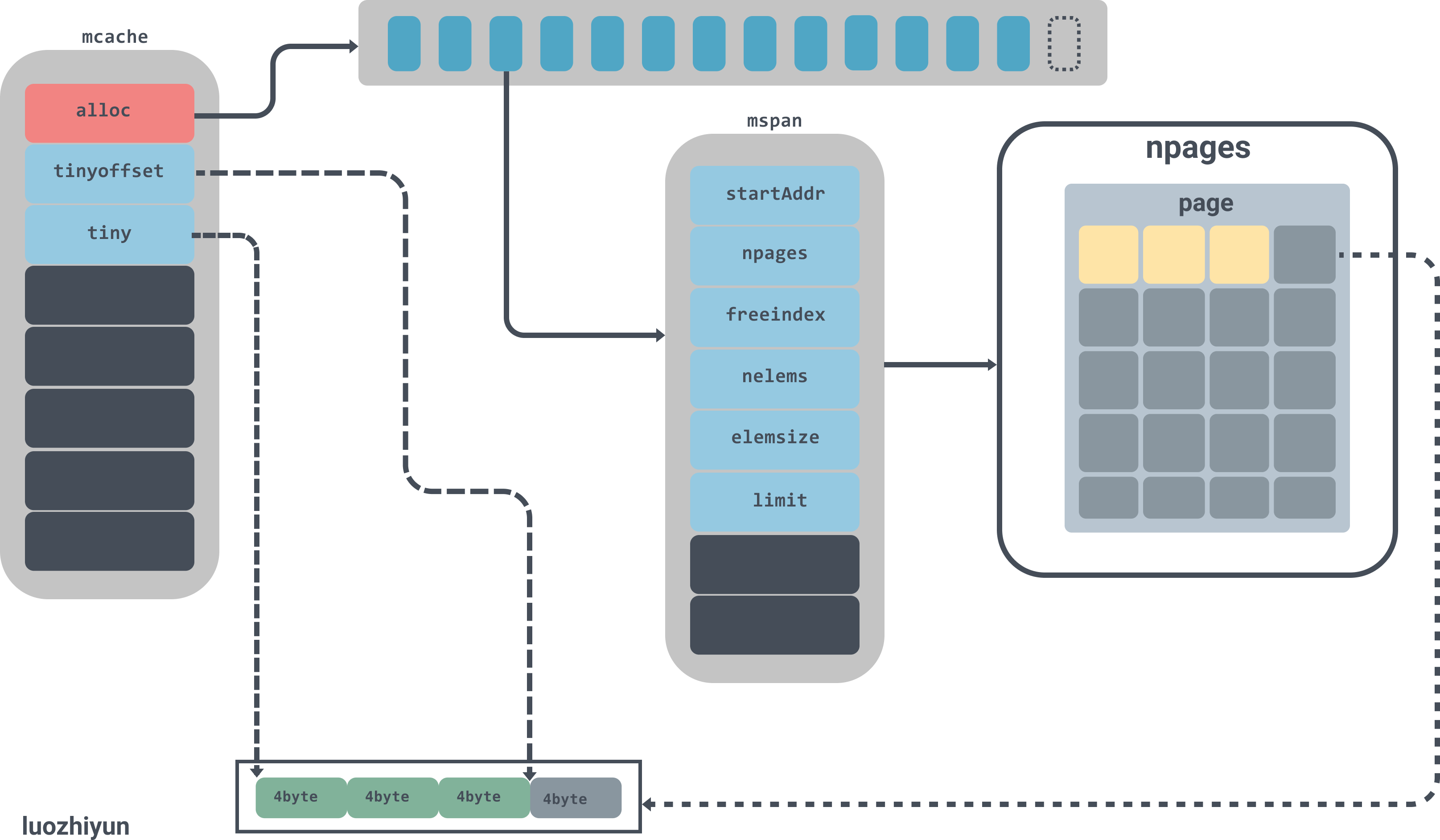
这里我再次使用我上面的图来加以解释。首先会去mcache数组里面找到对应的span,tinySpanClass对应的span的属性如下:
startAddr: 824635752448,
npages: 1,
manualFreeList: 0,
freeindex: 128,
nelems: 512,
elemsize: 16,
limit: 824635760640,
allocCount: 128,
spanclass: tinySpanClass (5),
...
tinySpanClass对应的mspan里面只有一个page,里面的元素可以装512(nelems)个;page里面每个对象的大小是16bytes(elemsize),目前已分配了128个对象(allocCount),当然我上面的page画不了这么多,象征性的画了一下。
上面的图中还画了在page里面其中的一个object已经被使用了12bytes,还剩下4bytes没有被使用,所以会更新tinyoffset与tiny的值。
总结
本文先是介绍了如何对go的汇编进行调试,然后分了三个层次来讲解go中的内存分配是如何进行的。对于小于32k的对象来说,go通过无锁的方式可以直接从mcache获取到了对应的内存,如果mcache内存不够的话,先是会到mcentral中获取内存,最后才到mheap中申请内存。对于大对象(>32k)来说可以直接mheap中申请,但是对于大对象来说也是有一定优化,当大对象需要分配的页小于16页的时候会直接从pageCache中分配,否则才会从堆页中获取。
Reference
https://chai2010.cn/advanced-go-programming-book/ch3-asm/ch3-09-debug.html
https://deepu.tech/memory-management-in-golang/
http://goog-perftools.sourceforge.net/doc/tcmalloc.html
https://draveness.me/golang/docs/part3-runtime/ch07-memory/golang-memory-allocator
本文同步分享在 博客“luozhiyun”(CNBlog)。
如有侵权,请联系 support@oschina.cn 删除。
本文参与“OSC源创计划”,欢迎正在阅读的你也加入,一起分享。
来源:oschina
链接:https://my.oschina.net/luozhiyun/blog/4938696